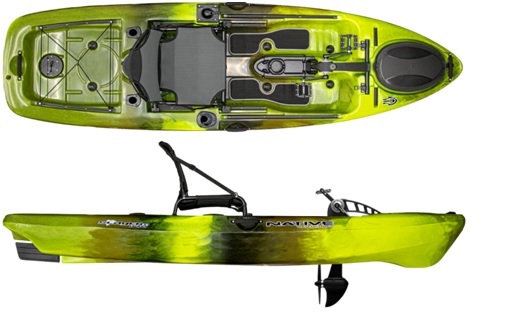Posted by Forrest on Nov 1st 2023
Finding Largemouth Bass in the Fall: Tips and Tactics
Kayaks like the Native Slayer Propel 10 let you travel light. They may have plenty of storage space in the bow hatch as well as rod holders, rail mount systems for accessories, and a unique propel pedal drive system with forward and reverse functionality, but they’re still light enough (81 lbs fully rigged) to load on a car top effortlessly.
If you’re traveling light with a Native Slayer Propel 10 (or similar kayak) and forgoing the battery and electronics, you’ll have to “fall back” on these tips for finding fish in the fall.
No fishfinder? No problem. Here are some top tactics.
Find the Warm Water
When the warm water of summer starts to taper off, fish start to get sluggish. They naturally will gravitate towards areas that have warmer water.
There are a few ways to target them. One is to find sources of artificially warmed water. If your lake has a power plant on it and you can get near where the water is discharged, that water will often be several degrees above the ambient lake temperatures. Fish will flock to it as the water cools (this should also be an area to target in winter).
If there are shallow flats with dark, muddy bottoms, especially on the unshaded, north shores of lakes, these are also great areas to target on sunny days especially because the bottoms will warm up under direct sunshine, and fish will hold there. Target midday and afternoon in these locations after they have had several hours to warm up.
Another tip is to check transition areas and deeper water. Bank dropoffs, rip rap and slopes, which encounter deeper water, will not cool as quickly as the shallower water near the shoreline. Sometimes fish will gather at these transition areas and school there to take advantage of the greater thermal inertia of the deeper water.
Structure Is Still Good

For smaller lakes without much depth, or on rivers, structure is still going to hold fish, just as it did in the summer.
In this respect, these are still areas to target during the fall, and in some ways, targeting structure will be even more lucrative in the fall.
This is because as weeds, reeds, and other aquatic plants start to wither and die off, baitfish and other invertebrates will become more desperate to find cover and they will often cluster thickly around what weeds are left. This makes these areas magnets for itinerant largemouths still hoping to gorge themselves before winter comes.
Other areas to target are submerged piles, ragged shoreline, clusters of rocks and riprap, docks and bridge footings which often trap more debris. These places are snaggy, but they often hold bait, and therefore, predators like largemouth bass.
Follow the Bait and Match the Hatch
In the fall, when largemouths get their first whiff of winter, they will want to feed as heavily as possible before the temperatures really dip. This heavy feeding will sustain them through the cold winter months when food will be hard to come by.
Not only should you target areas where bait will be clustered - such as around remaining weeds, downed trees and clusters of rock - but you should also give the bass what they expect.
If bass are gorging on shiners and shad, throw them spoons and crankbaits in appropriate colors and patterns. If they’re feeding on eels, crayfish, or shrimp, try large plastic worms or creature baits.
One general tip is to use brighter colors and larger baits at this time of year. You need to catch their attention and convince them that there’s a large meal to be had; a bass that feels winter coming would rather work less for a full belly than harder for a few small mouthfuls.
Adding Sensory Attractors
Because bass innately know that winter is coming, they might be less willing to take a chance on an unfamilair bait or one that isn’t as convincing, for lack of a better term.
This makes it more important at this time of year (as well as in the winter) to add what fishermen call “sensory attractors.”
Arguably the most convincing sensory attractor is scent. Large, scented soft baits tend to perform well (at all times of year) when other baits don’t. You can rely on commercial scents, such as those produced by Berkley’s PowerBait and Gulp, or you can soak your plastics in your own scents. Garlic, coffee, and anise-scented oils are popular, as are salted baits.
Metals and plugs can be scented, too. Add a trailer of scented plastic or a piece of worm or cut bait to one of your trebles and see if that increases your chances of hook-up.
Sound and sight are also two senses not to overlook. As stated, now is a good time of year to use brighter, contrasting colors, and rattling baits are often the ticket as well. Consider rattling plugs and if you’re fishing a softbait, add a spinner blade to your leader, or add a teaser to the tail. Fall can also be a great time to roll big buzzbaits over cover; that flash and thump will get attention at this time of year.
Get Your Next Native Slayer Propel 10 Here

If you’re a spring and summer-only fisherman, make this season the one to change that. Fall fishing for warmwater species like largemouth can be challenging, without a doubt, but armed with tips like these, all you can do from this point forward is learn more and gain experience. Get yourself a lightweight, easy-traveling cartop fishing kayak like a Native Slayer Propel 10 and start hopping local holes.
You might even catch a personal best. Who knows.

